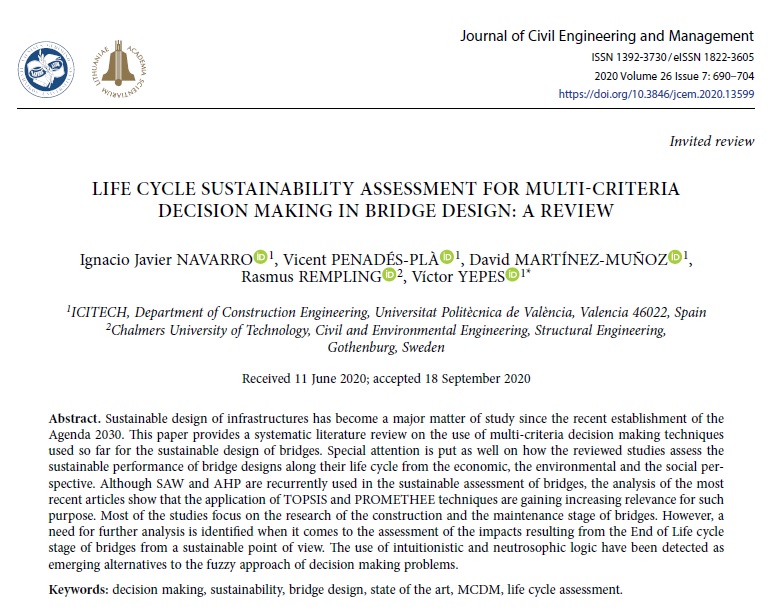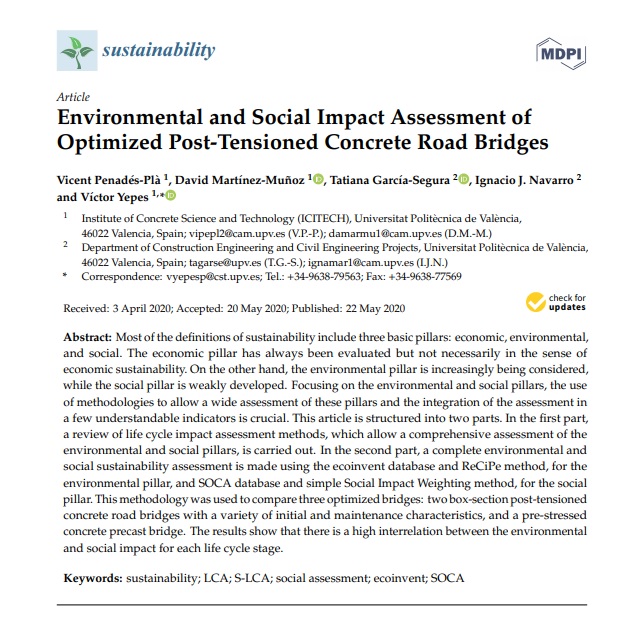 Acaban de publicarnos un artículo en la revista Journal of Civil Engineering and Managament, indexada en Q2 del JCR. Se trata de una revisión del estado del arte de la toma de decisiones multicriterio en el análisis sostenible del ciclo de vida de los puentes.
Acaban de publicarnos un artículo en la revista Journal of Civil Engineering and Managament, indexada en Q2 del JCR. Se trata de una revisión del estado del arte de la toma de decisiones multicriterio en el análisis sostenible del ciclo de vida de los puentes.
El trabajo se enmarca dentro del proyecto de investigación DIMALIFE que dirijo como investigador principal en la Universitat Politècnica de València.
El diseño sostenible de las infraestructuras se ha convertido en un importante tema de estudio desde el reciente establecimiento de la Agenda 2030. En este artículo se ofrece una revisión sistemática de la bibliografía sobre la utilización de las técnicas de toma de decisiones basadas en criterios múltiples utilizadas hasta ahora para el proyecto sostenible de puentes. También se presta especial atención a la forma en que los estudios evalúan el comportamiento sostenible de los diseños de los puentes a lo largo de su ciclo de vida desde las perspectivas económica, ambiental y social. Aunque SAW y AHP se utilizan de manera recurrente en la evaluación sostenible de los puentes, el análisis de los artículos más recientes muestra que la aplicación de las técnicas TOPSIS y PROMETHEE están adquiriendo cada vez más relevancia para tal fin. La mayoría de los estudios se centran en la investigación de la construcción y la etapa de mantenimiento de los puentes. Sin embargo, se identifica la necesidad de un análisis más profundo cuando se trata de evaluar los impactos resultantes de la etapa del fin del ciclo vital de los puentes desde un punto de vista sostenible. Se ha detectado el uso de la lógica intuitiva y neutrosófica como alternativas emergentes al enfoque difuso de los problemas de toma de decisiones.
ABSTRACT
Sustainable design of infrastructures has become a major matter of study since the recent establishment of the Agenda 2030. This paper provides a systematic literature review on the use of multi-criteria decision making techniques used so far for the sustainable design of bridges. Special attention is put as well on how the reviewed studies assess the sustainable performance of bridge designs along their life cycle from the economic, the environmental and the social perspective. Although SAW and AHP are recurrently used in the sustainable assessment of bridges, the analysis of the most recent articles show that the application of TOPSIS and PROMETHEE techniques are gaining increasing relevance for such purpose. Most of the studies focus on the research of the construction and the maintenance stage of bridges. However, a need for further analysis is identified when it comes to the assessment of the impacts resulting from the End of Life cycle stage of bridges from a sustainable point of view. The use of intuitionistic and neutrosophic logic have been detected as emerging alternatives to the fuzzy approach of decision making problems.
KEYWORDS:
Decision making, sustainability, bridge design, state of the art, MCDM, life cycle assessment.
REFERENCE:
NAVARRO, I.J.; PENADÉS-PLÀ, V.; MARTÍNEZ-MUÑOZ, D.; REMPLING, R.; YEPES, V. (2020). Life cycle sustainability assessment for multi-criteria decision making in bridge design: A review. Journal of Civil Engineering and Management, 26(7):690-704. DOI:10.3846/jcem.2020.13598











